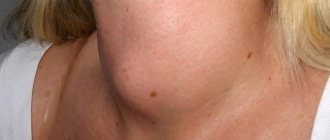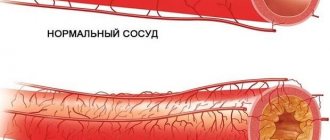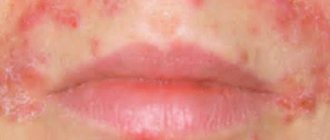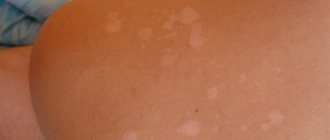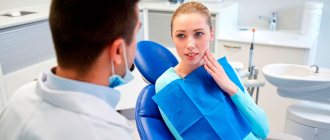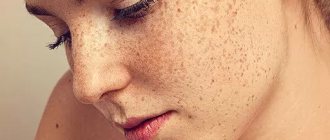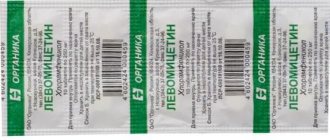The skin is a protective organ of a person, which not only performs its assigned functions, but also reflects the condition of the entire organism as a whole. Any changes in the condition of the skin may indicate the presence of negative external influences, or the development of serious diseases.
Red spots on the legs are pronounced changes in the color of the dermatological integument that appear in one area of the skin. The cause of the appearance of this defect on the limbs can be both cosmetics and pathological changes that occur inside the body.
If the disease is not treated, then after some time it will begin to slow down all metabolic processes and this will immediately affect the formation and functioning of pigment cells. If their work is disrupted sufficiently, unsightly spots begin to appear on the skin.
Red, rough spots on the legs: what to do?
Rough patches on the skin can result from atopic dermatitis.
- If you know for sure that the appearance of red spots was caused by cosmetics or detergents, then simply eliminate the source of irritation and use hygiene products without fragrances and dyes to care for your limbs for a couple of days
- If everything is in order with your body, then after 3-4 days the skin will return to its normal color and you will again be able to feel confident in public.
- But if the spots do not disappear, and their foci only increase in size, then you need to seek help from a specialist
- Usually such patients are offered to undergo venography and, of course, a complete examination of the whole body. If any pathology of internal organs is found, further treatment will be carried out comprehensively
- The doctor will select remedies that will help fight both one and the other pathologies at the same time. If for some reason you cannot quickly see a doctor, then try to alleviate your condition with antihistamines and ointments that have anti-inflammatory properties
Pathological causes
Spots on the legs can appear for many reasons. By its appearance and accompanying symptoms, you can understand what caused the rash and how to treat it. Often the causes of the appearance of red dots are various diseases. [ads1]
Allergy
Allergies are one of the most common causes of spots on the legs and entire body. She may be:
- Food. This allergic reaction is associated with the consumption of allergenic foods. This could be nuts, honey, citrus fruits, dairy products, sweets, etc.
- Medication. An allergy to medications can be caused by the body's hypersensitivity to individual components of the drug, as well as by improper use or overdose. Most often, unpleasant symptoms, including the appearance of red spots on the legs, are associated with taking antibiotics, but other types of medications can also provoke a negative reaction.
- Contact. An allergic reaction is triggered by contact with an allergenic substance. These include cosmetics, unsuitable hygiene products, and contact with plant juice or pollen on the surface of the skin.
The most common types of allergies that cause red spots on the legs are atopic and contact dermatitis.
Eczema
Eczema is a skin disease in which red spots of varying sizes appear on the skin of the legs or other parts of the body. They are often dry, itchy, covered with a crust that flakes off. But sometimes ulcerations appear on the surface of the rash. In this case, the disease is called weeping eczema. [ads2]
The disease can develop against the background of frequent allergic reactions, as well as numerous pathologies of internal organs. The risk group includes diabetics, patients with weak immunity and HIV infection.
Psoriasis
Psoriasis develops when the body begins to actively produce skin cells, as a result of which there are more of them than necessary. The development of the disease can be the result of severe stress, injury, infectious diseases, taking certain types of medications, or bad habits. [ads3]
Psoriasis is an immune disease, the development of which is difficult to predict and prevent. Moreover, it cannot be completely cured - you can only relieve the symptoms and put the pathology into remission.
Folliculitis
Inflammation of the hair follicles is most often observed on the lower extremities. [ads4]
The disease affects mainly women, although it can also develop in men (in this case, not only on the legs). The main cause of folliculitis is mechanical damage to the skin. For example, while shaving.
Fungal infection
The fungus most often affects the toes, but can also develop on the feet and legs. The disease is very contagious and is easily transmitted through personal contact. Also, mycosis of the skin of the legs can develop after undergoing a course of treatment with powerful antibacterial drugs. [ads5]
Fungus of the lower extremities is a common occurrence in people with excessive sweating of the feet. Wearing underwear made from synthetic materials can also cause this disease. The skin becomes irritated under the influence of unnatural components, microcracks can form on it, through which fungi can penetrate into its thickness.
Lichen
Lichen planus is another cause of spots on the legs. The disease is not transmitted by contact, so it is not dangerous to others. According to experts, the development of LP is associated with genetic conditioning. The pathology is accompanied by severe itching, peeling, and burning. At the same time, it is accompanied by psychological discomfort that the patient experiences during the next attack of unpleasant symptoms. [ads6]
This type of lichen can be determined at home. To do this, the red plaque must be lubricated with any vegetable oil and wait for the result. It won't take long to notice: white dots and/or lines will appear on the surface of the rash.
It is impossible to completely cure this pathology. But if you seek help from a doctor and undergo a course of symptomatic therapy, the disease may not bother the patient for a long time.
Blood vessel diseases
Red spots on the legs that itch and cause discomfort can appear not only due to the development of skin pathologies. Many disorders of the internal organs can also lead to the formation of such a rash. In particular, these may be diseases of the blood vessels:
- thrombosis;
- vasculitis;
- phlebeurysm;
- venous hyperemia.
With the above pathologies, spider veins or large red spots may appear on the surface of the skin. As the disease progresses, the skin rashes on your legs will begin to itch.
The appearance of itching is a very alarming symptom that you should not turn a blind eye to. He speaks of a serious circulatory disorder and the development of complications of the disease.
Erysipelas
Erysipelas, or erysipelas, is an infectious skin disease caused by streptococci. With this pathology, a spot forms on the leg - large or small - with an intense, bright red tint. It itches a lot and causes discomfort – physical and psychological.
Erysipelas is accompanied by other symptoms, the most common of which are hyperthermia and general malaise. An existing spot can grow over time, covering healthy areas of the skin. Along with the defect, discomfort also grows.
The cause of streptococcal infection can be injury: a scratch, wound, microcrack, cut. In some cases, even a violation of the integrity of the skin under the nail plate on the toe can contribute to the development of erysipelas of the skin.
Allergy to the sun
Allergy to the sun is one of the types of dermatitis - photodermatitis (or photodermatosis). In this case, red spots appear on the legs, as well as on other parts of the body, including the face. They are very itchy, painful and cause physical and psychological discomfort.
Symptoms of photodermatitis can develop immediately or after some time after exposure to the sun. The process of disease development takes from several hours to 1-2 weeks. The cause of unpleasant symptoms may be:
- some types of medications (hormones, antibiotics, NSAIDs, etc.);
- Food;
- cosmetics (creams, perfumes, etc.).
There are categories of the above mentioned products that increase the body's photosensitivity. Therefore, you should avoid using or consuming them before going out into the sun.
Diabetes
The formation of red spots on the skin of the lower extremities is a common occurrence in diabetes mellitus. The spots are itchy and may also be weeping. Due to poor circulation in the legs, spotted growths may have a red-violet hue. In some patients they are accompanied by pain.
Severe itching forces the patient to frequently scratch the rash. This leads to injuries, wounds and ulcers. These lesions can then become infected by a bacterial or fungal infection, significantly worsening diabetes.
Scabies
Scabies is a parasitic skin disease caused by the scabies mite. It has the ability to penetrate into the thickness of the skin, leaving behind a barely noticeable furrow. If indeed the cause of itching on the legs lies in this disease, then the red spots will look like small, numerous dots. After scratching, they may turn white and pink.
Helminthiasis
Helminths are parasites whose waste products cause increased sensitization in the human body. The consequence of this is a small spotty rash on the body or in certain areas, for example, on the legs.
Liver and kidney diseases
With liver and kidney diseases, toxins accumulate in the body. They are not completely eliminated from it, but circulate in the blood and enter the internal organs. The skin is one of the first to suffer from such disorders.
Red dots form on it, which can be located on any part of the body, including the lower limbs. The spots are very itchy and may peel off. At the same time, depending on the affected organ (liver or kidneys), other unpleasant symptoms of the pathological process appear.
The best remedies for flaking, red spots and itching
When red spots and peeling appear on the surface of the limbs, you should immediately begin treatment. But only a doctor can prescribe an effective and most suitable remedy. He makes a preliminary diagnosis and establishes the main cause that caused the rash.
What can you buy at the pharmacy?
Before prescribing a suitable drug, an examination is carried out. It helps to identify the disease or condition that caused the red spots with peeling and other unpleasant symptoms.
Important! Under no circumstances should you start using medications on your own. You should definitely consult your doctor first. If the medication is chosen incorrectly, serious health problems can arise.
Depending on the diagnosis, drugs from different groups can be used:
- Antihistamine type. These medications are prescribed in the presence of allergic reactions. The most effective include “Fenistil”, “Suprastin”, “Zodak”, “Citrine”;
- Antimiconics. Medicines included in this group are used to treat fungal diseases. Fluconazole, Nystatin, Clotrimazole have a good effect;
- Sorbents. The drugs help cleanse the body of toxins and waste that provoke allergic reactions. Among the effective sorbents are Enterosgel, activated carbon;
- Anti-inflammatory drugs. Often with rashes there is a feeling of burning, itching, pain, severe irritation, swelling, and inflammation. The use of such products as Zinc ointment, Irikar, Bepanten help eliminate unpleasant phenomena;
- Hormonal medications. Drugs such as Hydrocortisone ointment, Advantan, and Flucinar help eliminate red spots in psoriasis, eczema, and severe dermatitis.
Rashes often form when the immune system is weakened and vitamin deficiency occurs. In these situations, vitamin complexes are prescribed - “Alphabet”, “Vitrum”, “Complivit”, “Elevit Pronatal” and others.
Home Recipes
Homemade remedies are recommended to be used as an addition to primary medical therapy. They will help quickly eliminate unpleasant symptoms and speed up the recovery process.
The most effective folk remedies include:
- Pickle from sauerkraut. It is recommended to lubricate stains that appear due to allergies with liquid;
- For severe redness, you should use a decoction of oak bark. Pour 1 large spoon of the plant into a bowl and pour a glass of boiling water. It takes about 20-30 minutes to insist. Areas with stains are treated with a decoction;
- If the redness is very itchy and flaky, then you can use raw potatoes. To do this, rub it through a fine grater. The mixture is applied to areas with rashes as a compress for 15 minutes.
Note! To alleviate the condition and eliminate severe itching, you can take baths with medicinal plants - chamomile, celandine, birch leaves and buds. They will speed up the process of eliminating all unpleasant rashes.
What do experts advise?
Treatment of rashes on the legs with different etiologies should be carried out by specialists. They will be able to select the most suitable therapy that will quickly eliminate the main cause of redness.
Many experts advise following the following recommendations:
- If the spots appear due to allergies, then in addition to using medications, you should follow a special diet and devote more time to active exercises;
- If red spots on your legs are very itchy and itchy, then it is better to use antihistamines and absorbents;
- Psoriasis and eczema often cause scaly patches. In these situations, it is necessary to undergo comprehensive treatment, which will be aimed at eliminating the main symptoms;
- If rashes appear due to varicose veins, then treatment should be carried out under the supervision of surgeons. For this pathology, venotonics are used;
- In case of hypothermia and bruises of the leg, it is necessary to rub it well using alcohol, vodka or ointments with a warming effect.
Important! Under no circumstances should you self-medicate. If you don’t know the main reason that triggered the rash, you will definitely choose inappropriate therapy, which will cause serious harm instead of benefit.
For more information about the causes of itching and spots on the legs, as well as treatment methods, watch the video:
Non-pathological causes of red spots on legs
Often, the appearance of red dots on the skin of the lower extremities is not associated with exposure to pathological factors. The formation of such a rash is possible when the human body is exposed to external irritants, which are quite easy to eliminate.
Prickly heat
Heat rash on the legs is caused by overheating and excessive sweating associated with poor hygiene. But it can also be a consequence of hyperhidrosis as one of the symptoms of various diseases. Most often, the rashes are localized in the area of the popliteal skin folds. The rash causes discomfort and may be painful or accompanied by a burning sensation.
Reaction to cosmetics and hygiene products
Not all cosmetic and hygiene products for body skin care are suitable for every person. In addition, some manufacturers use high-quality ingredients to make such products, and replace them with cheap chemical analogues - flavors, dyes and other elements.
Nervous disorders, stress
Itchy red spots on the skin of the legs appear in people who are in a state of chronic stress, or are often exposed to severe nervous and emotional shocks. Typically, such rashes do not require specific treatment, since they go away on their own after normalization of the nervous system.
Sudden temperature changes
When temperature changes, blood vessels sharply narrow and dilate. Due to the fact that they do not have time to adapt to new conditions, redness and itching occurs in the lower extremities, arms, torso or face. Some patients call this condition “cold allergy,” but this is not entirely true. In fact, unpleasant symptoms can occur both when entering a warm room from a frost, and when leaving into the sun from a cold room.
Other causes of redness on the legs
Red dots and spots on the legs that itch and cause discomfort may also appear for other reasons not related to disease. These include:
- insect bites;
- depilation;
- frequent sugaring, peeling, scrubbing the skin of the legs;
- burns;
- bruises and abrasions;
- frostbite;
- weathering;
- frostbite.
Also, itchy red spots on the legs can be the result of a banal neglect of hygiene rules. In this case, you can avoid their appearance by taking a shower regularly. In summer, you need to wash your feet from dust and sweat at least 4-5 times a day.
What types of stains are there?
A flawless epidermis is a huge wonder. The occurrence of a skin rash is not considered a pathology. But some types of exanthems may indicate the development of some disease. also indicate infection, an allergic reaction, or other ailments.
In general, spots are areas that differ in color from the nearby dermis. These rashes are usually smooth to the touch, but there are times when they are a little rough. Such changes in the skin can be divided into 3 main groups:
- Vascular . They usually have a pink or reddish tint. This is predetermined by the structure of blood capillaries.
- Pigmented . Such rashes are brownish or white in color. Formed due to lack of melanin.
- Unnatural origin. This type is the result of the introduction of a dye into the skin.
Lichen
Ringworm is the most common skin disease. Accompanied by typical modifications of the dermis. Usually occur due to a weakened immune system . There are different types of lichen that lead to the formation of a rash:
- Zhiber's pityriasis rosea - pinkish rashes or clearly defined red zones that can cause peeling and peeling of the epidermis;
- lichen planus - a purple-colored rash that occurs not only on the integument, but also on the mucous membrane;
- shingles - reddish, inflamed areas that become blistered;
- pityriasis appearance - pale rashes that may peel off;
- Ringworm - spots that are very itchy and itchy, and also cause hair loss at the site of occurrence.
Is it possible to cure a hypertensive crisis with folk remedies?
Find out in this article what to do if a vein in your leg bursts.
Reds
Absolutely every person has encountered this problem. Such rashes can be caused by a number of reasons . If the illness is accompanied by a rise in temperature, husking, swelling, headaches, itching, burning and other visible signs, then immediate help from a specialist is needed.
Light
The appearance of spots that are slightly lighter than the entire cover brings a lot of worry. Typically, such defects are the result of healing of wounds and abrasions. But in some cases they may have quite serious underlying causes .
- Red spots on the legs due to varicose veins - treatment methods and possible causes
Pigment
This type of stain can have a variety of shades. There are similar spots:
- Hyperpigmented. Formed when there is a strong increase in pigmentation.
- Hypopigmented. Appear due to a decrease in melanin. This type may be associated with the progression of various diseases.
If a red spot appears on your leg, the photo can be compared to a guide to determine the root cause.
Associated symptoms
Red spots on the legs rarely occur in isolation from other symptoms. In most cases they are accompanied by:
- itching;
- swelling;
- pain;
- peeling;
- redness of the skin around the spot;
- an increase in local temperature;
- crust formation;
- the appearance of wet areas.
In fact, these are the safest accompanying symptoms that may indicate the presence of inflammatory, allergic, and infectious skin lesions. But there are also clinical manifestations that require immediate consultation with a doctor, since they indicate the presence of pathologies of internal organs. So, you need to make an appointment with a doctor if:
- severe weakness;
- hyperthermia;
- extreme thirst;
- dry mouth;
- headaches;
- nausea;
- the formation of bubbles or vesicles at the location of the red spots;
- the appearance of ulcers in the area of red dots;
- yellowing of the skin;
- darkening of urine;
- lower back pain;
- bitterness in the mouth;
- urinary disorders, etc.
The above symptoms are observed in liver, kidney, and endocrine disorders. They cannot be delayed in treatment, so their combination with red spotty rashes on the legs should be a good reason for immediately seeking medical help.
When to see a doctor
If spots with a red tint appear on your legs, which are accompanied by peeling, severe itching, burning, and pain, you should immediately consult a doctor. Do not delay, it is better to visit a specialist at an early stage, otherwise dangerous health problems may arise.
When reddish spots increase greatly, you should not think that this is a temporary phenomenon. In most cases, this may be a consequence of the development of a dangerous disease. During the examination, the doctor must pay attention to the nature of the rash, size and quantity.
Diagnostics
If itchy red spots appear on your legs, you should consult a dermatologist. Before visiting a specialist, you do not need to smear the rash with brilliant green or iodine, as this may complicate diagnosis.
To begin with, an initial survey of the patient is carried out, during which he talks about when the spots began to appear, what preceded this and what accompanying symptoms they are accompanied by. Next, dermatoscopy is performed - examination of the affected areas of the skin using a special medical instrument - a dermatoscope.
If necessary, a tissue sample is taken from the surface of the rash for further microscopic examination. It allows you to determine the type of causative agent of a dermatological disease. Based on the results of such a test, the doctor can prescribe the most effective treatment.
If the red spots on the legs are not related to skin pathologies, the patient may be referred to other specialists:
- allergist;
- neurologist;
- endocrinologist;
- hematologist;
- cardiologist;
- oncologist.
Only on the basis of a comprehensive diagnosis will the doctor be able to prescribe correct and effective treatment.
Atopic dermatitis and its differences from psoriasis
Atopic dermatitis may also cause dry patches to appear on the body. And as with psoriasis, they cause itching. Due to the increased sensitivity of the skin to environmental factors, the mechanisms of its self-regulation are disrupted, including the barrier function. That is, the trigger for atopic dermatitis is an allergy, but the tendency to such a skin reaction is genetically determined.
Most often, atopic dermatitis occurs in children. The disease has a chronic course, when exacerbations are replaced by periods of remission. Here are the typical signs of atopic dermatitis:
- dry skin;
- peeling and redness of the eyelids;
- dry flesh-colored plaques on the trunk and extensor areas of the body;
- cracks.
It is difficult for a person without medical education to distinguish psoriasis from atopic dermatitis, but a doctor can easily make a differential diagnosis. There are several differences that may speak in favor of one or another pathology. Atopic dermatitis most often affects children, psoriasis can debut in adulthood. Psoriatic plaques are raised above the skin, and scales can be seen. Dry spots in atopic dermatitis are flat. It is also important to consider the typical location.
Useful links: State Center of Urology in Moscow - Clinic of Urology named after R. M. Fronshtein of the First Moscow State Medical University named after I.M. Sechenov
Treatment
Treatment for red spots on the legs depends entirely on the cause of their appearance. In most cases, local medications are used, but sometimes systemic medications are necessary.
Effective for itchy spots on the legs:
- Antihistamines. They are prescribed for allergic spots on the skin of the lower extremities. Taken orally 1-2 times a day (depending on the generation and the specific drug). Tablets Fenkarol, Levocetirizine, Cetrin, etc. have good effectiveness.
- Antifungal ointments. Used for skin mycoses and lichen. Apply to the previously cleaned and dried affected area. Clotrimazole, Nystatin, Exoderil can be used.
- Hormonal ointments. For psoriasis, eczema, and severe skin allergies, ointments and creams based on hormonal components are used. These are Hydrocortisone, Dexamethasone, Kremgen. It is undesirable to use them without a doctor’s prescription, since they can cause severe side effects, including skin atrophy.
- Hyposensitizing agents and local antiallergic drugs. Fenistil, Boro-Plus, Bepanten or regular baby creams with chamomile or calendula will help eliminate redness, irritation, and itching on the skin of the feet. It is advisable to use them for hyperemic spots that appear under the influence of external irritating factors - after depilation, insect bites, use of low-quality body cosmetics, etc.
- Antiparasitic ointments. Used to treat scabies. Sulfur and iodine ointments, drugs Spregal, and Permethrin ointment are excellent in destroying scabies mites.
For helminthiasis, antihelminthic drugs are prescribed. They are selected after stool analysis, since it is important to determine the type of helminths. Based on the results obtained, you can select the most effective anthelmintic agent.
Folk remedies
Along with medications, for red spots on the legs that itch and cause discomfort, it is useful to use traditional medicine recipes. They will be effective for skin irritation, allergies, insect vinegar, frostbite.
Popular folk remedies:
- Herbal decoctions and infusions. In particular, medications based on chamomile, marigold, eucalyptus, and St. John's wort are good at eliminating itching and redness. You can make lotions and compresses, or simply wipe problem areas on your feet. But if the itching is unbearable, then it is recommended to freeze the broth and then wipe the spots with it. This approach will help eliminate discomfort.
- In case of fungal infection, it is recommended to use an infusion of celandine. At 8 tbsp. l. herbs you need to take 3 liters of boiling water and steam. Keep covered for 45 minutes, then strain and add to a bath of water or basin. Immerse your feet in the solution and keep it until it cools completely. The infusion can be used for compresses, but to do this you need to pour 1 spoon of the raw material into a glass of boiling water.
- Viburnum juice. It has antiseptic, anti-inflammatory, analgesic properties. Used to wipe away red spots resulting from allergies, fungus, and skin irritation.
If the red spots on the legs are flaky and occur due to excessive dryness of the skin, then rubbing coconut or olive oil into the epidermis in the morning and evening will help get rid of them. Carry out the procedure after taking a shower or bath.
Preventive measures in this case are simple. It is necessary to carefully monitor body hygiene, use only high-quality and suitable cosmetics, refuse to take medications on your own, and eat a healthy and balanced diet. It is also recommended to avoid contact with stray animals, but if this fails, after coming home you should wash your hands well and treat them with an antiseptic: this will prevent the infection from spreading to other parts of the body.
